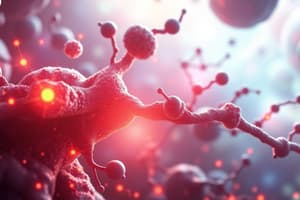Podcast
Questions and Answers
What is the process by which ATP is synthesized during respiration?
What is the process by which ATP is synthesized during respiration?
- Oxidative phosphorylation (correct)
- Photophorylation
- Electron transport
- Proton consumption
What is the main function of fimbriae in Gram-negative bacteria?
What is the main function of fimbriae in Gram-negative bacteria?
- Respiration
- Adherence to surfaces (correct)
- ATP synthesis
- Bacterial movement
What is the term used to describe the hair-like structures on the surfaces of procaryotic cells?
What is the term used to describe the hair-like structures on the surfaces of procaryotic cells?
- Cilia
- Pili (correct)
- Fimbriae (correct)
- Flagella
What is the role of the F or sex pilus in E. coli?
What is the role of the F or sex pilus in E. coli?
What is the main function of common pili in bacteria?
What is the main function of common pili in bacteria?
What is the role of fimbriae in pathogenic Neisseria gonorrhoeae?
What is the role of fimbriae in pathogenic Neisseria gonorrhoeae?
What is the term used to describe the process by which ATP is synthesized during photosynthesis?
What is the term used to describe the process by which ATP is synthesized during photosynthesis?
What is the role of fimbriae in bacterial virulence?
What is the role of fimbriae in bacterial virulence?
What is the purpose of Gram staining in bacterial cell identification?
What is the purpose of Gram staining in bacterial cell identification?
What is the function of murF in peptidoglycan precursor biosynthesis?
What is the function of murF in peptidoglycan precursor biosynthesis?
What is the function of uppS in cell wall biosynthesis?
What is the function of uppS in cell wall biosynthesis?
What is the composition of the peptidoglycan layer in bacterial cell walls?
What is the composition of the peptidoglycan layer in bacterial cell walls?
What is the function of murG in peptidoglycan precursor biosynthesis?
What is the function of murG in peptidoglycan precursor biosynthesis?
What is the function of the peptidoglycan layer in bacterial cell walls?
What is the function of the peptidoglycan layer in bacterial cell walls?
What is the name of the enzyme responsible for cross-linking between amino acids in different linear amino sugar chains?
What is the name of the enzyme responsible for cross-linking between amino acids in different linear amino sugar chains?
What is the function of bacA in biosynthesis?
What is the function of bacA in biosynthesis?
Which of the following bacterial species has a peptidoglycan layer containing L-alanine, D-glutamine, L-lysine, and D-alanine with a 5-glycine interbridge between tetrapeptides?
Which of the following bacterial species has a peptidoglycan layer containing L-alanine, D-glutamine, L-lysine, and D-alanine with a 5-glycine interbridge between tetrapeptides?
What is the function of Alash?
What is the function of Alash?
What is the result of cross-linking between amino acids in different linear amino sugar chains?
What is the result of cross-linking between amino acids in different linear amino sugar chains?
What is the function of Flippase?
What is the function of Flippase?
Which of the following groups of microorganisms does not contain peptidoglycan?
Which of the following groups of microorganisms does not contain peptidoglycan?
What is the family of proteins that Flippases belong to?
What is the family of proteins that Flippases belong to?
What is the function of mraY in peptidoglycan precursor biosynthesis?
What is the function of mraY in peptidoglycan precursor biosynthesis?
What is the shape of the freshly added septal material of synthesis in bacterial cell walls?
What is the shape of the freshly added septal material of synthesis in bacterial cell walls?
What is the primary function of GTase (EC 2.4.1.129 Enzyme)?
What is the primary function of GTase (EC 2.4.1.129 Enzyme)?
What is the function of Tpase (EC 3.4.16.4 Enzyme)?
What is the function of Tpase (EC 3.4.16.4 Enzyme)?
What are teichoic acids composed of?
What are teichoic acids composed of?
Where are teichoic acids typically found?
Where are teichoic acids typically found?
What is the function of lipoteichoic acids?
What is the function of lipoteichoic acids?
What is the difference between lipoteichoic acids and wall teichoic acids?
What is the difference between lipoteichoic acids and wall teichoic acids?
What is the process by which phospholipid molecules move between the two leaflets of a cell's membrane?
What is the process by which phospholipid molecules move between the two leaflets of a cell's membrane?
What is the term for the movement of phospholipid molecules between the two leaflets of a cell's membrane?
What is the term for the movement of phospholipid molecules between the two leaflets of a cell's membrane?
What is the function of Lipopolysaccharide (LPS)?
What is the function of Lipopolysaccharide (LPS)?
What is the function of Mg++ bridges?
What is the function of Mg++ bridges?
What is the function of Braun lipoprotein?
What is the function of Braun lipoprotein?
What is the function of Omp C and Omp F proteins?
What is the function of Omp C and Omp F proteins?
What is the function of Omp A protein?
What is the function of Omp A protein?
What is the composition of S-layers?
What is the composition of S-layers?
Where are S-layers typically located in Gram-negative bacteria?
Where are S-layers typically located in Gram-negative bacteria?
What is the thickness range of S-layers?
What is the thickness range of S-layers?
Flashcards are hidden until you start studying
Study Notes
ATP Synthesis
- ATP can be synthesized by the membrane-bound ATPase enzyme, which consumes protons during ATP synthesis from ADP and phosphate.
- The connection between electron transport, establishment of proton motive force (pmf), and ATP synthesis during respiration is known as oxidative phosphorylation, and during photosynthesis, it is called photophorylation.
Fimbriae and Pili
- Fimbriae and pili are interchangeable terms used to describe short, hair-like structures on the surface of procaryotic cells.
- They are composed of protein, shorter and stiffer than flagella, and slightly smaller in diameter.
- Fimbriae are generally involved in adherence of bacteria to surfaces, substrates, and other cells or tissues in nature, rather than bacterial movement.
- In E. coli, a specialized type of pilus, the F or sex pilus, stabilizes mating bacteria during conjugation, but the function of smaller, more numerous common pili is different.
Gram Staining
- Gram staining is a procedure used to stain bacteria, developed by Hans Christian Gram in 1884.
- Gram-positive cells stain purple, while Gram-negative cells stain red.
Peptidoglycan Layer
- The peptidoglycan layer is a crystal lattice structure formed from linear chains of two alternating amino sugars, N-acetylglucosamine (GlcNAc or NAGA) and N-acetylmuramic acid (MurNAc or NAMA).
- The alternating sugars are connected by a β-(1, 4)-glycosidic bond.
- Each MurNAc is attached to a short amino acid chain, containing L-alanine, D-glutamic acid, meso-diaminopimelic acid, and D-alanine in the case of Escherichia coli (a Gram-negative bacterium).
- Peptidoglycan is one of the most important sources of D-amino acids in nature.
- The peptidoglycan layer protects the cell from lysis caused by the turgor pressure of the cell, and it retains its shape throughout its life.
Enzymes Involved in Peptidoglycan Synthesis
- DD-transpeptidase is involved in cross-linking between amino acids in different linear amino sugar chains.
- murF, mraY, and murG are enzymes involved in peptidoglycan precursor biosynthesis.
- uppS is involved in cell wall biosynthesis, providing the precursor for the carrier lipid, undecaprenyl phosphate (C55-P).
Flippase
- Flippase is a transmembrane lipid transporter protein located in the membrane, which belongs to the ABC transporter or P4-type ATPase families.
- It is responsible for aiding the movement of phospholipid molecules between the two leaflets that compose a cell's membrane (transverse diffusion, also known as a "flip-flop" transition).
Teichoic Acids
- Teichoic acids are bacterial copolymers of glycerol phosphate or ribitol phosphate and carbohydrates linked via phosphodiester bonds.
- They are found within the cell wall of most Gram-positive bacteria, such as species in the genera Staphylococcus, Streptococcus, Bacillus, Clostridium, Corynebacterium, and Listeria.
- They can be covalently linked to N-acetylmuramic acid or a terminal D-alanine in the tetrapeptide crosslinkage between N-acetylmuramic acid units of the peptidoglycan layer.
Lipopolysaccharide (LPS)
- LPS is a component of the outer membrane of Gram-negative bacteria, serving as a permeability barrier, endotoxin, and serotyping agent.
- Mg++ bridges stabilize LPS and are essential for its permeability characteristics.
S-Layer
- S-layers are a part of the cell envelope found in almost all archaea, as well as in many types of bacteria.
- They consist of a monomolecular layer composed of only one (or, in a few cases, two) identical proteins or glycoproteins.
- S-layer proteins are poorly conserved or not conserved at all, and can differ markedly even between related species.
Studying That Suits You
Use AI to generate personalized quizzes and flashcards to suit your learning preferences.





